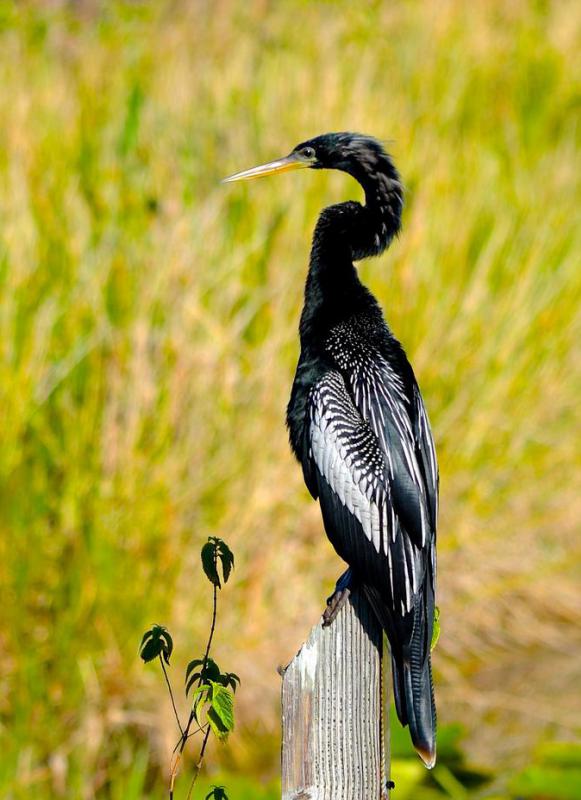At AllThingsNature, we're committed to delivering accurate, trustworthy information. Our expert-authored content is rigorously fact-checked and sourced from credible authorities. Discover how we uphold the highest standards in providing you with reliable knowledge.
What is an Anhinga?
The anhinga is a large water bird. It typically measures approximately 29.5 to 37.4 in (75 to 95 cm) in height, and weighs about three lbs (1.35 kg). Often found near rivers, sloughs, marshes, lakes, and similar habitats, it prefers the warm climates found from the southeastern U.S. to the nation of Argentina.
It has a long, pointed bill, which it uses to spear and eat fish. The male is usually dark in color, except for some lighter patches on its wings. Females generally have lighter coloring, particularly on their neck and chest feathers. Unlike many other large fishing birds, the anhinga lacks oil glands to waterproof its feathers. This allows it to quickly dive into water for fish, but it must periodically perch and dry its wings out.

The anhinga’s genus and species is anhinga anhinga. It is also sometimes known as a snakebird. This name comes from the way it swims when its feathers are waterlogged. It is also due to that fact, when it is swimming, the bird's long, thin neck and relatively thin head typically look very much like a water snake. It is also known as a water turkey, because of its broad, long tail. Although its coloring is primarily dark, the anhinga has a greenish iridescence to its dark feathers.
Other than fish, the anhinga has been known to eat baby alligators. It also consumes crayfish, insects, and frog eggs, among other creatures. When the anhinga spears fish with its pointed bill, it sometimes spears them so hard that it is necessary for it to swim to shore to remove the fish from its bill before eating it.
Anhingas are often confused with cormorants, but many differences exist between the two water birds. Cormorants have a flatter, less pointed, and yellower bill. They also do not have light coloring present on their wings, as the anhinga does. Cormorants can also live in colder habitats, and migrate in the winter to warmer areas. Also, anhingas have longer tails and necks, and flap their wings and soar while in flight, while cormorants generally only flap and do not soar while flying.
Anhingas mate monogamously. The male starts a potential nest site, and soars during courtship. The birds may build their own nest, or use one that belonged to a heron or egret. In fact, anhingas often nest among groups of herons and egrets. Female anhingas usually lay about four eggs, which hatch after a 29-day incubation period. Although dependent on their parents for some time, hatchlings can swim away from danger if necessary.
Frequently Asked Questions
What is an Anhinga and where can it be found?
An Anhinga, often referred to as the "snakebird," is a water bird known for its swimming prowess, where only its neck protrudes above the water, resembling a snake. These birds are commonly found in warm freshwater environments such as swamps, marshes, and shallow coastal waters of the Americas, from the southeastern United States down through Mexico, Central America, and into South America.
How does the Anhinga adapt to its aquatic habitat?
The Anhinga is superbly adapted to its aquatic lifestyle with a long, slender neck, and sharp, pointed bill for catching fish. Its feathers are not completely waterproof, allowing it to reduce buoyancy and dive easily. After diving, it needs to spread its wings to dry them, as wet feathers can hinder flight.
What does the Anhinga eat and how does it hunt?
Anhingas are primarily piscivorous, meaning their diet consists mostly of fish. They hunt by diving underwater and spearing fish with their sharp beaks. They may also eat amphibians and invertebrates. Anhingas have been observed to swim slowly and stealthily, using their flexible neck to strike quickly at prey, which they then bring to the surface to swallow.
Is the Anhinga an endangered species?
As of the current knowledge cutoff, the Anhinga is not considered an endangered species. It is listed as "Least Concern" by the International Union for Conservation of Nature (IUCN), indicating that it does not currently face a significant risk of extinction in the wild. However, like many species, it is affected by habitat destruction and environmental pollution.
How do Anhingas reproduce and raise their young?
Anhingas are monogamous birds that engage in elaborate courtship displays. They build nests in trees or shrubs near water, where the female lays 2 to 6 eggs. Both parents share incubation duties and later, feeding the chicks by regurgitating food. The young are cared for by the parents until they are ready to fledge and hunt on their own.
What unique behaviors do Anhingas exhibit?
Anhingas are known for their distinctive sunning behavior, where they spread their wings wide to dry after diving, due to their less waterproof feathers. This behavior is crucial as it allows them to maintain the ability to fly. They are also unique in their silent nature, as they lack the vocal muscles that enable other birds to produce a wide range of sounds.
AS FEATURED ON:
AS FEATURED ON:











Discuss this Article
Post your comments